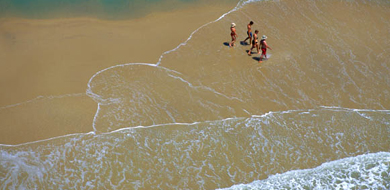Aquiraz beach
 Fortaleza
Fortaleza
 Beaches in Ceara
Beaches in Ceara
 Sun Rising Coast
Sun Rising Coast

Distance from Fortaleza: 32 km (20 mi)
See map of beaches East of Fortaleza.
Access to Aquiraz is by CE-40, or following avenues and roads alongside the coast heading Eastbound from Fortaleza.
The name Aquiraz is of Indian origin and means "the water is close ahead". There are several lagoons and fountainheads in the area, which flow into the sea just a few kilometers East of Aquiraz.

Walking along Prainha, in Porto das Dunas
Aquiraz has an important historical role in Ceará because it was the first capital of the state and has tourist attractions to tell the story.
The population is about 70,000, but has been growing quickly. Aquiraz is seeing a fast increase in the number of new residents (usually, tourists who decide to settle for good); this is just like the same situation faced by Cumbuco, in the Western boundary of Fortaleza, and, also just like Cumbuco, the growth has caused concerns about the environment and the infrastructure capacity.
Being a neighbor to a hectic city like Fortaleza doesn't disturb the peace in the beaches of Aquiraz. In Porto das Dunas, for instance, excellent hotels receive the most demanding guests. The place is known for one of the biggest water parks on a beach in South America: Beach Park.
Besides water slides, waterfalls, snack bars, restaurants, ecologic tours and helicopter and glider flights, the park has a resort and tourist complex offering suites with an ocean view, a game room, a gym and other attractions.
On one side, the sea, on the other, the view of the beautiful wind mills on the dunes. Prainha is also highlighted, a place where artists paint jangada sails, portraiting the everyday life of the fishermen before they go to sea in a competition that happens every year, called Navegarte.
Batoque beach, an extractive reserve, is considered to be an example of environmental preservation and peace. In Iguape, the Lacemaker Center and the works made there, and the beautiful landscape of the beach, struggle for the tourists' attention.
There are places to visit, beside the beaches. In the town, the Religious Art Museum and the Jesuits' ruins preserve the History of Aquiraz. Another attraction is the Art Market, which has artistic shows and workshops.
São José de Ribamar Sacred Museum

Opened in 1967, the Museum exhibits today about 640 pieces, among silver objects, china, images of saints, chandeliers and crosses, most of them donated by Jesuit priests. A rare piece found at the São José de Ribamar Sacred Museum, is the image of Our Lady of Santana from Portugal. It is made of polychromatic wood from the 18th century.
Many of these pieces are made of wood in colonial style, dating back to the 17th century. What draws most attention of Brazilians are the so called 'Santos do Pau Oco', which translates as 'Saints of the Hollow Wood'; these are statues with a hollow interior, where Brazilians hode gold to escape the tax collectors; until today, 'santo do pau oco' is a slang to refer to someone who hides their true intentions.
The museum building used to be the old House of Representatives. In 1742, the building was the Public Jail of the region. It is now protected by the Cearense historical patrimony. The museum is on 22 Cônego Araripe Square, Downtown. Entrance is free.
More information on Aquiraz
»Aquiraz official site. Maintained by the city Government.
»Aquiraz Shopping Center. Commercial guide.
»Hotels in Aquiraz and Porto das Dunas. Near Beach Park.